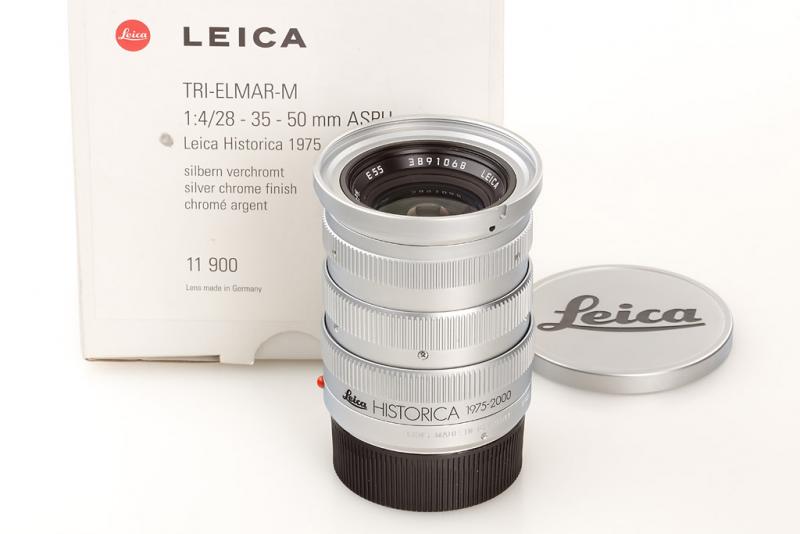Tri-Elmar-M 28-35-50 mm f:4,0 ASPH (I)
Características
Código - 11 890 negro - 11 894-cromado (conocido como "MATE" Medium Angle Tri-Elmar) LLC - 132
Producción - 1998-.....
Números de serie:
Variantes - Negro y cromado
Montura - Bayoneta Leica M Códigos 6 bits a partir de 2006
Angulo de visión diagonal, horizontal, vertical: 28 mm: 75° / 65° / 46° - 35 mm: 63° / 54° / 38° - 50 mm: 47° / 40° / 27°Diseño Óptico:
Número de lentes/grupos - 8 /6Intérvalo de enfoque: - 1 m a infinito
Longitud focal efectiva -
Posición de la pupila de entrada - 408 mm
Escalas: combinada, metros/pies, con lineas grises tenues por debajo de 0,7 m.
Campo visual mínimo: 28 mm: 750 x 1130 mm, 35 mm: 620 x 930 mm, 50 mm: 430 x 650 mm
Factor de reproducción: 28: 1:31 - 35: 1:26 - 50: 1:18
Diafragma - f/4-f/22 con click, valores intermedios, diafragma manual tipo iris de 8 hojas
Montura de filtros: E55 -
Parasol: 12458
Acesorios: visor: U12011
Longitud hasta la bayoneta - 67.8 mm
Diámetro máximo - 55 mm
Material: aluminio anodizado negro
Peso - aprox. 340 g
Inscripción - LEICA TRI-ELMAR-M 1:4/28-35-50 ASPH. E55 (Serial No.) Diseño:
Referencias
Erwin Puts
For a while Konica manufactured the Hexar RF, a rangefinder camera with much Leica-M DNA. One of the lenses for this camera was the Hexanon 1:3.4 ? 4/21-35 Dual. It was a very complex design with eleven elements in ten groups, but delivered high quality. The front group did not move, but the back group did shift over a small distance to select the two focal lengths.
The original proposal for zoom lens design for the M-camera also featured two focal lengths, but the final version incorporated three selectable focal lengths: 28, 35 and 50.
The Tri-Elmar lens is a landmark design in optical and mechanical construction and an engineering feat of daunting complexity.
From its optical design the Tri-Elmar is a true zoom lens. A zoom lens alters the focal length of the optical system and thus changes the magnification of the image when you take pictures from a fixed standpoint. The designer accomplishes this by employing two groups of lens elements, a back and a front cell. When both groups are shifted relative to each other and relative to the film plane the focal length is changed. The front group also moves axially for the adjustment of the distance setting. The demands on the mechanical engineering are extremely high. Cams with different curves mechanically compensate the relative movement between the two cells and with respect to the film plane. The change from 50 to 35 and from 50 to 28 requires the same distance on the focal-length setting ring, but the internal movements are quite different, where the shorter distance requires a steeper curve. This results in different forces to overcome and these forces need to be linked to the tensions of the frame actuating springs.
The first version of the Tri-Elmar-M 1:4/28-35-50 mm ASPH. drew some complaints about the somewhat indifferent lock for the 28mm position.
The second version, introduced at Photokina 2000 has the same optical cell, but improved ergonomics, with a focusing tab and improved selection mechanism for the focal lengths. It is also smaller than the predecessor with a 49 mm mount and a slightly shorter mount. It may be noted that the Tri-Elmar-M is the lens where the art and tradition of precision mechanical engineering and mounting is close to its current zenith. Both versions combined have been sold more than 10.000 times.
The image quality of the lens is outstanding at all three focal lengths, even at full aperture. Some distortion is visible at the 28mm position, but almost gone at the other focal lengths. The 50mm position in particular is highly recommended because here quality is on a par with the current Summicron-M 1:2/50 mm.
Existe una versión cromada con motivo del 25 aniversario de la sociedad alemana Leica Historica
Ésta página ha sido vista 3.509 veces
-
-
Creado por elultima actualización por , el
-


